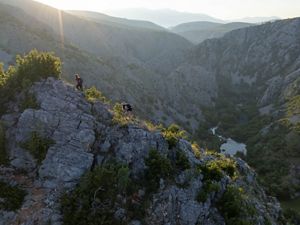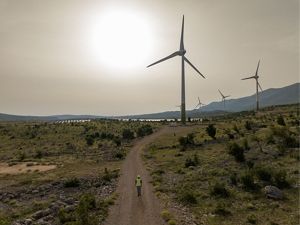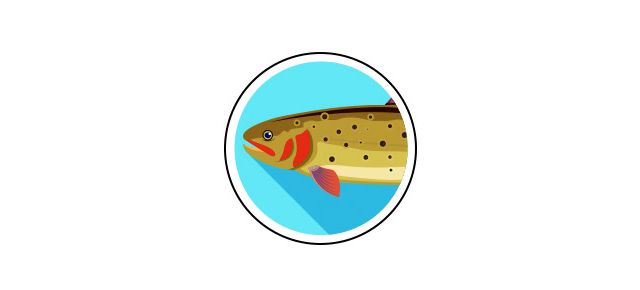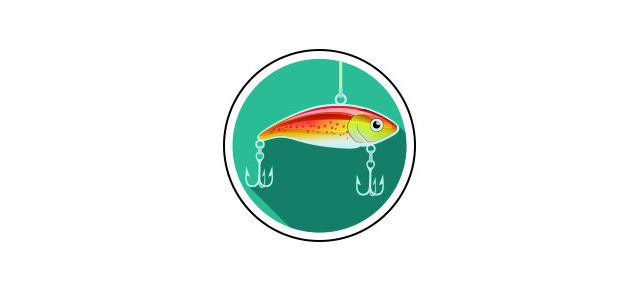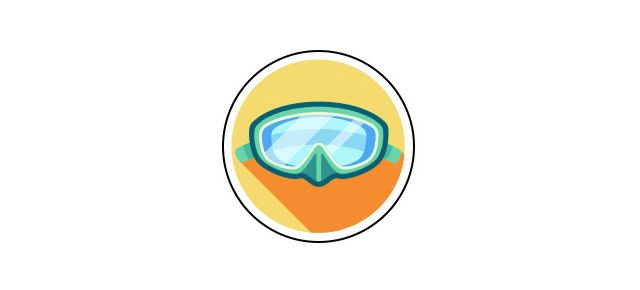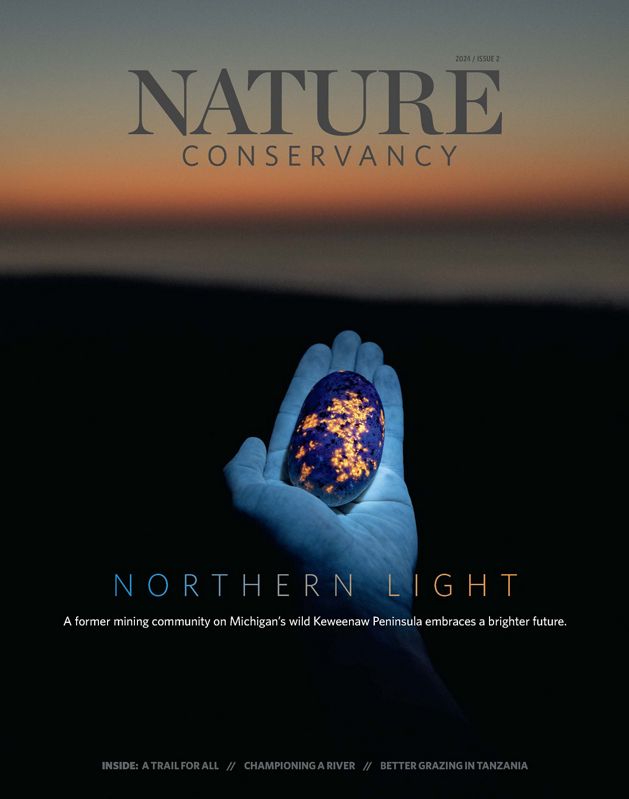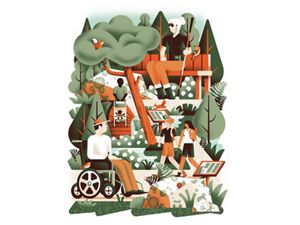
Float On Beti Kotovchevska swims in the Došnica River in North Macedonia—a practice she says helped her heal after a car accident. © Ciril Jazbec
Some of Europe’s last free-flowing rivers weave through the craggy mountains and dense forests of the western Balkan Peninsula, north of Greece and separated from Italy by the Adriatic Sea. Their sparkling turquoise waters are hot spots of biodiversity, home to rare and endemic fish, amphibians, aquatic invertebrates and algae. But these rivers face threats both long-standing—illegal dumping, industrial pollution—and imminent, from thousands of proposed dams that would alter their flow and disrupt their ecology. In recent years, The Nature Conservancy has pushed to establish official protection for the region’s fresh water, achieving some heartening successes. But there’s more to be done, and much will be up to the people who live and work along the rivers’ banks.
“We have many rivers just on the edge of being proclaimed as protected,” says Irma Popović Dujmović, who leads TNC’s freshwater program in Croatia, “while some are still under huge threats from hydropower.”
The decline of river health in Southeast Europe
Worldwide, as of 2020, only 15% of rivers are both free-flowing and within protected areas, which makes Southeast Europe’s fresh water globally significant. The Conservancy, working with other local and international groups, notched a significant victory in 2019 with the permanent protection of Croatia’s Krupa River. Now, TNC and six local partners have started a campaign called United for Rivers, to protect 250 miles of waterways across five Western Balkans countries: Bosnia and Herzegovina, Croatia, Montenegro, North Macedonia and Serbia. The campaign has already achieved a significant milestone with the legal protection of Croatia’s Mrežnica and Tounjčica Rivers earlier this year.

“In the past, the focus in the region’s protected areas was on land rather than the water, but now we want to put the focus of protection on the fresh water,” Popović Dujmović says, explaining that legal protection of a river’s natural flow is the only permanent way to block dams. “If the water is officially protected, then it changes the game.”
Dotting these countries are villages, towns and cities whose residents depend on these rivers for drinking water, irrigation, climate moderation and a sense of home. These relationships between humans and water date back millennia, but in the 20th century, industry—including surface coal mining—altered people’s perceptions of their environment and their rivers. In some communities, local people lament, rivers became little more than channels for pollution or dumping grounds for household trash.


Falling back in love with local rivers to save them
More recently, however, a grassroots contingent of everyday people—farmers, divers, scientists, fishermen, business owners, local elected officials—has come together to advocate for fresh water, not only as an ecological treasure that must be cared for, but as an economic resource in a region where development has long lagged behind the rest of Europe.
“People come here because of the beauty and health of this ecosystem,” says Popović Dujmović, who lives in Zagreb, Croatia, nestled between craggy Mount Medvednica, with its myriad streams and waterfalls, and the Sava River, a turquoise tributary of the Danube. “Everybody benefits from it, and now it’s time to pay back a bit of our debt, identify threats and find solutions that will be applicable on the local level.”
To celebrate and encourage local efforts, TNC and United for Rivers have designated several “River Champions”—advocates for their communities at the national and regional levels—in part as an inspiration for other local residents to fall in love with their rivers again.
“The River Champions are the face of the process, but everybody else is important,” Popović Dujmović says. “If we don’t have a buy-in from the local people who use these rivers, protection will not be accomplished.”
Based on the work of locals, North Macedonia has revoked hydropower concessions, Bosnian legislators are debating river protection and Serbian officials are taking steps toward blocking poorly sited dams. But with many more dams still in the planning stage, the next few years will prove crucial for the future of fresh water in Europe.
Based at the University of Kragujevac, Tijana Veličković studies fish and other animals in the Veliki Rzav, one of the cleanest and most biodiverse waterways in Europe. Her research is helping to inform the pending creation of the Veliki Rzav River Special Nature Reserve, which protects an area where 450 species of plants and animals make their homes.
“I remember even as a child I was fascinated by the fact that on the surface of a river everything is calm, while beneath it there’s a vast and enchanting world. As a biologist, I want to understand the organisms that live in that world, and I feel the responsibility to use all my knowledge to preserve these habitats.
“Many rare species of algae can be found in the Veliki Rzav, and also macroinvertebrates, such as crayfish, which are adapted to this fast, oxygen-rich water. One of the species I am most interested in is the brown trout. It’s one of the best-studied species, yet there is much we don’t know about its evolution.
“It’s very important to regularly carry out biological monitoring, because we need to know what we have in order to protect it, and to increase the ecological awareness of the people living by the river. If the river could speak, it would tell us that we can enjoy all its beauties, but with care and respect.”
Andon Krstevski grew up in Demir Kapija, an ancient village on the banks of the Vardar River, but he left to go to college in France. After years working at wineries in Europe and New Zealand, Krstevski returned to Macedonia in 2011; he is now the technical director at Stobi Winery, 20 miles upstream from his hometown.
“My connection with the Vardar River is natural and deep. When I was away, I missed the murmur of this river. But the river is also closely related to the wine. It is the pathway of the winds that blow between the Mediterranean and the North. The winds enable a very dry climate, which does not allow diseases to harm the vines.
“In Macedonia, there are still no sewage treatment plants, and major factories release organic or chemical waste into the Vardar. On the banks of the river, we can see plastic bottles and plastic bags. We set up an ecological association to give an example with small actions, and we’ve collected a lot of waste.
“Awareness is gradually increasing, and this river is restoring its lost species. We saw turtles that were thought extinct for 50 years. We saw birds that returned. I have an enormous hope that this river will be clean. Without clean water, and a clean river, there are no healthy vines, healthy grapes or healthy wine.”

Energy for the Future
The countries of the Western Balkans have lagged behind Western Europe economically, largely as a legacy of conflict in the 20th century. For energy, the region still depends on aging, inefficient coal plants, some of which date to the Communist era. While local people, environmental activists and regional leaders all hope to leave this polluting industry in the past, advocates for the regions’ rivers argue that the thousands of small-scale hydropower plants proposed in recent years would damage freshwater resources.
“We can resolve the climate issue without jeopardizing biodiversity and the interest of communities,” says Igor Vejnović, director of strategic initiatives for TNC in Southeast Europe.
In recent years, the Western Balkans have embraced renewable energy as an alternative—and there’s plenty of potential in this windy region that can see nearly as much sunshine as the French Riviera. The Conservancy has developed a process to identify sites for wind and solar power infrastructure that will have the least impact on wild habitat and cultural resources, and it’s working with local partners to inform future projects.
In North Macedonia, for example, TNC and its partners have mapped over 11 gigawatts of solar and wind potential on strategically chosen land like the soon-to-be-retired surface coal mine near the village of Oslomej, where a solar farm with a planned capacity of 120 megawatts is already operational.
“This region has a renewable energy future,” Vejnović says. “There are enough resources. It just needs to be planned in a smart way.”

Vaso Knežević grew up playing and sunbathing on the banks of the Ćehotina River, near his hometown of Pljevlja. The river has since been diverted to accommodate an open-pit coal mine, and its lower course has become polluted. Knežević leads a nonprofit, Da Zaživi Selo (“Better life for a countryside”), which is working to raise the river’s profile among local people.
“I was first taken fishing by my grandpa. That’s how I fell in love with this river, and it has become an integral part of my life. The Ćehotina River for me is a place to rest my soul.
“In the last 50 years, the Ćehotina has been devastated due to the development of coal mining, and the thermal plant, as well as sewage water. The citizens have become alienated from the river, and we throw everything we don’t need into it, hoping that the river will take it away. Now, we have to pay back our debt to this river.
“We have organized a series of eco actions, cleaning and removing garbage. We have made movies about the Ćehotina River, with all of its natural potential—and all the pollutants that are its huge threat. These are steps to bring the Ćehotina River closer, first for the citizens of Pljevlja to get to know it, and then everyone else.”
The medieval city of Mostar, Bosnia, is renowned for its high stone bridge, Stari Most—and for the centuries-old tradition of jumping off of it into the Neretva River. A trained scuba diver, Sanja Mitrić is a member of Mostar’s Neretva Diving Club, which organizes annual efforts to collect garbage and encourage local people to take better care of their river.
“Not every diver can take part in a cleanup campaign in a river like the Neretva. You need to have experience. The Neretva has a strong current and you need to know it. It’s very cold and fast. When I dive in the Neretva, I see that there’s still life in it. We see many plants and animals in the river, but even more rubbish. I feel both admiration and anger with every dive.
“For me, the Neretva represents life. It has a great tourist potential. But our people don’t appreciate it and protect it as they should. Every year we clean up the river, hoping that people will become more aware, that younger generations will have a different attitude towards this beauty, and that they’ll realize its great potential. I want the river to be crystal clear in the future, as it should be, to be drinkable throughout its course, to be free of litter, to be protected and for people to be proud of it.”
About the Creators
Ciril Jazbec is a photographer and filmmaker based in Slovenia. His work has been published in National Geographic Magazine and TIME, among others.
Amy Crawford writes about the environment, cities, history and art from her home in Michigan. She has been published in Smithsonian, Slate and more.
